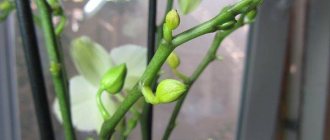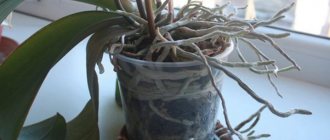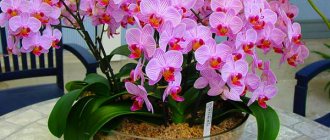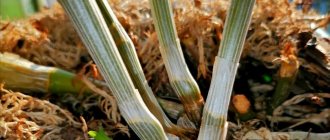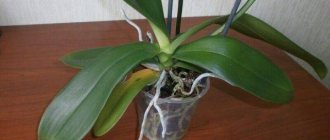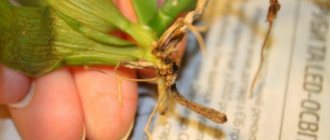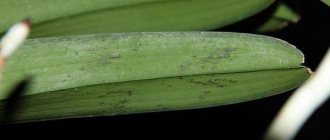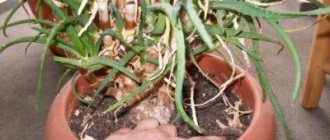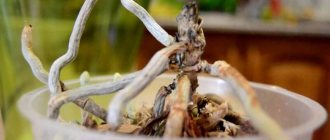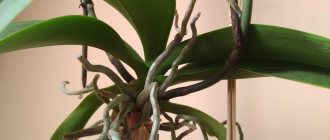Plants » Flowers
2
1662
Article rating
Kira Stoletova
Orchids are moderately demanding of the conditions created for them; many factors influence the growth and development of the flower. There are a number of reasons why an orchid turns yellow. You can save flower stalks and prevent the infection from spreading further, the main thing is to start treating the plant in a timely manner.
Causes of yellowing orchids
Watering
- Poor quality of watering is the first reason for poor health. Do not use hard water filled with excess salts and metals. If this is the cause of the plant’s painful condition, then the lowermost leaves of the orchid will be the first to turn yellow, and all subsequent ones will be covered with yellow spots. If the plant is dormant, it needs to be urgently transplanted into a new substrate. If flowering is in full swing and replanting is impossible, water the plant with distilled water diluted 50/50 and regular water that has settled from the top to the base.
- Lack of moisture - check the soil regularly; if it dries out, place the flower pot in a large container of water for 30 minutes, then let the water drain completely and return the phalaenopsis to its original place.
- Excessive watering will lead to rotting of the roots, their lethargy, weeping spots will appear and the leaf will soon fall off. If overwatering occurs and the root rots, then you should transplant the orchid into a new substrate, removing the damaged areas, but first wait for it to bloom.
Why do orchid leaves turn yellow?
More recently, the orchid could be classified as an exotic plant, but now it can be seen in almost every home and office, and usually not in one copy. The fact is that absolutely all types of orchids are distinguished by their grace and beauty; they are not like the plants that grow in our latitudes. It is also no secret to the owners of these beauties that orchids are fastidious plants and quickly react to disturbances in growth conditions, stopping flowering and turning yellow. In this article we will try to figure out what to do when the leaves of an orchid turn yellow, what this reaction signals and why it spreads to other parts of the plant.
Leaves can turn yellow primarily through natural processes that occur in the plant's body. The lower leaves age, turn yellow and die, and in this case there is no reason to worry, this is a renewal process.
If yellowing affects the upper leaves and is widespread, you should pay attention to the watering system and intensity; most likely you have gone a little overboard with them. Excessive amounts of moisture have a very negative effect on orchids, causing yellowing and stimulating decay processes. In this case, the orchid is removed from the substrate, its roots are necessarily checked for the presence of rotting areas, carefully removed, and then the plant is planted in new fresh soil or bark.
The same disastrous result has the application of excessive amounts of fertilizers, especially flowering stimulants. Of course, you want the orchid to bloom as profusely as possible, but you are unlikely to be willing to pay for this with the health and life of your pet, so carefully read the dosage indicated on the package.
Fertilizers
If a previously healthy home orchid has suddenly turned yellow and dried out, the cause may be an overabundance of fertilizers. When the stem and flowers wither and the leaf falls off, you can save the phalaenopsis. To do this, rinse the substrate or replant the flower; you cannot feed it for the next few months; after that, only with diluted fertilizer.
If only the tips or lower leaves turn yellow and wrinkled, then the orchid suffers from an excess of calcium. Change the substrate. In this case, for a while the need for feeding disappears. If the orchid turns yellow on top, veins appear on the leaves and fall off over time, then the reason is a lack of potassium - use a special fertilizer.
The orchid peduncle turns yellow: when to worry and take action
Experienced flower growers know that after flowering, part of the peduncle turns yellow or all at once. This is a normal process and should be treated without fear. There is no need to remove the undried peduncle. You should wait until it dries completely, and then it can be easily removed by hand. If part of the peduncle turns yellow and dries out, and flower buds begin to grow on other parts, then the yellowed part should be cut off with a sharp, disinfected pruning shears. We cut above the dormant bud.
But yellowing is not always caused by natural causes. The problem may occur due to:
- Improper application of fertilizers. From an excess or, conversely, a lack of fertilizers, the peduncle may begin to turn yellow. Feeding must be done in a timely manner and in the required doses. If a flower does not have enough microelements, it will not be able to bloom. You can understand that it lacks nutrition by the following signs: first the buds will fall off; The flowers will be small and may begin to dry out quickly.
- Inappropriate lighting. Ideally, daylight should last from 12 to 14 hours. Lack of lighting slows down the process of photosynthesis. In this case, both the leaves, roots, and peduncle suffer.
| Advice. Choose south and south-east windows to place the pot. Other windows will require additional lighting. |
- Unsuitable indoor air humidity.
- Diseases.
- Various damage, including roots.
- Stress from moving and after transplantation.
If there is any yellowing, do not rush to remove the peduncle. Carefully inspect and observe the flower for several days. And only after understanding the reason, eliminate it.
Photo by O. Nikonorova: Do not rush to cut off the peduncle.
Diseases
The orchid dries out from fungal infections; they occur with frequent watering and affect the root system and trunk of the flower. If rotting is not stopped in time, it will also affect the leaves, causing them to turn yellow and fall off. It is necessary to take immediate action - replace the substrate, trim the affected areas and treat the phalaenopsis with an antifungal drug. For prevention, use fungicides.
Due to bacterial infections, the leaves turn sharply yellow, darken over time, become limp and wrinkled, and weeping spots appear with an unpleasant smell of rot. Isolate the plant, trim off the affected areas and treat the sections with iodine. Only after treatment with an antifungal drug can the flowerpot be returned to its original place.
What is the danger?
It's okay if yellowing is a natural process of aging. It is worse if the appearance of yellowed parts of the exotic indicates the presence of various kinds of diseases.
The main danger is not to delay, but to react to the first symptoms at the same time. Failure to provide timely assistance to a diseased plant can result in: complete drying of the roots, deterioration of the general condition due to infectious diseases, disruption of development, cessation of flowering, and death of the flower. We would like to tell you why an orchid’s roots and leaves dry out and turn yellow in a separate article.
Pests
Most of all, ticks and white-winged moths love the orchid. Due to mite infestation, the roots and trunk of the plant do not receive enough nutrients and moisture, the leaves are the first to react, they turn yellow and lose their elasticity. To save the flower, treat it with a special preparation and, after completing a full course of spraying, transplant it into a new substrate. When whiteflies appear, the flower is covered with a white, fine-grained coating, the leaves quickly wither and fall off, and the flower stalks may dry out. To restore the leaves, use a soap solution, it will remove plaque, then spray with a special solution against pests. The procedure is repeated for several weeks in a row until complete recovery.
Age
Old leaves may turn yellow and fall off
Leaves may turn yellow and fall off due to old age, but in their place, new, young, light green leaves will certainly grow. Usually the process begins with the lowest leaves, gradually rising up the trunk of the flower. There are also phalaenopsis hybrids that necessarily shed their foliage during flowering.
cramped potty
If the orchid has dried out and looks sickly, the cause may also be unfavorable growing conditions.
When the plant has grown and most of the roots are already outside the pot, or are squeezed in it, the roots become deformed and dry, the penetration of moisture and nutrients is difficult, as a result the leaves turn yellow and begin to fall down. Transplant the phalaenopsis into a pot of a suitable size, dividing it if necessary, being careful not to damage the buds and flower stalks. After transplantation, the plant will quickly return to normal.
Why does an orchid's stem turn yellow?
The stem of phalaenopsis orchids is called the peduncle and we will talk about the reasons for its yellowing in the next paragraph, but now we will focus on the no less popular “apartment” representative of orchids, dendrobium, the stem of which is considered to be a tuber.
Its yellowing and drying is a natural process. The fact is that flowers from each such stem can bloom only once, and then its function is already considered completed. Dendrobium performs some kind of self-cleaning. When it becomes noticeable that the tuber is turning yellow, there is no need to push it, just wait a little for it to dry and separate.
Stress
Orchids are delicate and capricious, sensitive to any changes. Changing lighting and temperature conditions, or moving to a new place are stressful. If the leaves turned yellow and fell off after the above changes, there is no need to guess why the flower dried up. The flower should get used to stressful situations gradually - move the pot to a new place for a couple of hours, then return it back.
The flower's homeland is the tropics, hence the love for humid environments. Dry air will cause leaves to turn yellow, dry at the tips and fall off. To revive it, provide the right level of humidity with a humidifier or frequent spraying, and the flower will quickly return to normal. If the soil is dry, rinse it under running water.
Care instructions
If the care rules are followed, but the orchid still dries out, try the following tips:
- Alternate the method of watering - immerse in a large container of water, and next time water from above, avoiding the lower leaves and trunk.
- Spray the flower regularly with warm water.
- If the roots are bright green, there is enough moisture in the substrate, if they have lightened and become silvery, water them immediately, the soil is drying out.
- After flowering, do not cut the flower stalks at the root; if they have not dried out, leave them alone, and after a while, carefully trim the dry areas.
- Use special soil for orchids, it contains pieces of bark.
- Cover the earthen ball with moss, this will protect it from drying out and retain moisture inside the pot.
- An orchid is replanted only during the dormant period, until the bulb appears and the peduncle has dried up.
If the phalaenopsis does not bloom for a long time, place it in a dark room and later return it to its place. A contrast shower also helps a lot - warm water first, then cool water. Soon she will delight you with a young shooter.
Prevention
- Maintaining a comfortable temperature in summer: +22-25ºС, in winter +16-18ºС.
- Place in partial shade, scorching rays should be shaded.
- Maintain humidity between 50-60% with a household humidifier.
- Be sure to regularly ventilate the room.
- The soil should be updated no more than once every 3 years.
- Water once a week; in between, the soil should dry out completely.
- Use warm and purified water.
- Orchids need to be fertilized 2 times a month, especially during the flowering period.
- It is better to spray the flower up to 5 times a day.
To achieve good results, long and lush flowering, you need proper care. Do not neglect the basic rules for growing orchids, as well as the parameters of the indoor microclimate. And as a result, yellowing of the peduncle will occur only due to natural aging.
